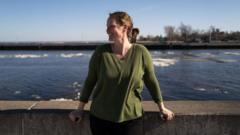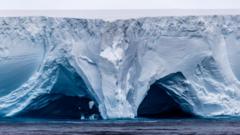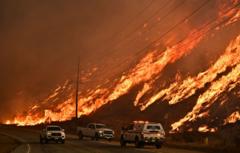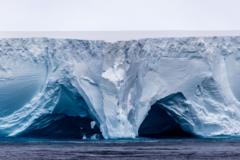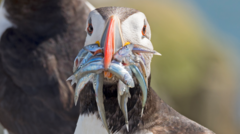Churchill, Canada, grapples with the effects of warming as polar bears encroach on town life, introducing new challenges and protective measures for residents.
**Clash of Species: Polar Bears and Residents Navigate a Warming Arctic**
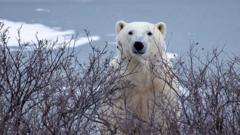
**Clash of Species: Polar Bears and Residents Navigate a Warming Arctic**
As climate change intensifies, a Canadian community learns to coexist with the world's largest predator.
In the cold reaches of Churchill, Canada, a town known as the polar bear capital of the world, both locals and polar bears are feeling the impacts of a warming environment. During a recent filming session with a BBC crew, the sighting of a polar bear required an immediate retreat into vehicles, underscoring the delicate balance between human life and wildlife in this unique area.
A confident 13-year-old girl named Tee at a local high school shared some insights on bear safety, saying, "If there's a bear this close to you, make a fist - and punch it in the nose." Although Tee hasn’t had to test this advice, growing up beside polar bears has made safety knowledge second nature. Signs across town remind residents to be “bear aware,” emphasizing that running from a charging bear is unwise, as they can reach speeds of up to 25mph (40kmph).
The town’s location along the Hudson Bay means that every autumn, as the sea ice begins to form, it's a prime gathering spot for polar bears, eager for their main prey—seals. Alysa McCall from Polar Bears International explains that the area’s unique geography causes freeze-up to occur here first, making it a crucial hunting ground for the bears. However, with rising temperatures leading to a longer ice-free period, the polar bear population in the Western Hudson Bay has faced significant decline—almost halving since the 1980s.
Conservation experts note that this change greatly affects the bears’ ability to sustain themselves. "Bears here are now on land about a month longer than their grandparents were," says Alysa. "That puts pressure on mothers. [With less food] it's harder to stay pregnant and to sustain those babies." This precarious situation creates a paradox: while the long-term future of polar bears seems bleak, short-term encounters with humans are increasing as bears remain on land longer.
To better understand and protect both the bears and residents, scientists are employing innovative technology. The Polar Bears International team is developing a radar system named "bear-dar," designed to detect bear movements and safeguard communities, adding a layer of security to daily life in this remote area.
The dedicated polar bear alert team is always on duty. Ranger Ian Van Nest reports on monitoring bears that show interest in town. When encounters occur, they rely on non-lethal measures, using live traps to relocate bears rather than causing harm. Their history speaks volumes—there hasn’t been a polar bear-related death in Churchill since 1983, thanks to the established safety protocols.
As the effects of climate change grow more evident, Churchill is preparing for the future. The newly opened Churchill Marine Observatory eyes shifting environmental conditions and explores potential impacts on local wildlife, as well as the expanded shipping seasons that might accompany an ice-free Hudson Bay.
Mayor Mike Spence remains optimistic. "We're already looking into extending the season," he stresses, acknowledging the town's adaptability. While the prospect appears bright for the community, the future of polar bears remains uncertain. Local students like Tee and her classmates express concern about the bears' dwindling visits, highlighting the ongoing challenge of living alongside these majestic but vulnerable predators.
As Churchill navigates the complexities of its surroundings, the future unfolds—a tale of resilience in the face of climate change, where both species must adapt to a rapidly changing world.
A confident 13-year-old girl named Tee at a local high school shared some insights on bear safety, saying, "If there's a bear this close to you, make a fist - and punch it in the nose." Although Tee hasn’t had to test this advice, growing up beside polar bears has made safety knowledge second nature. Signs across town remind residents to be “bear aware,” emphasizing that running from a charging bear is unwise, as they can reach speeds of up to 25mph (40kmph).
The town’s location along the Hudson Bay means that every autumn, as the sea ice begins to form, it's a prime gathering spot for polar bears, eager for their main prey—seals. Alysa McCall from Polar Bears International explains that the area’s unique geography causes freeze-up to occur here first, making it a crucial hunting ground for the bears. However, with rising temperatures leading to a longer ice-free period, the polar bear population in the Western Hudson Bay has faced significant decline—almost halving since the 1980s.
Conservation experts note that this change greatly affects the bears’ ability to sustain themselves. "Bears here are now on land about a month longer than their grandparents were," says Alysa. "That puts pressure on mothers. [With less food] it's harder to stay pregnant and to sustain those babies." This precarious situation creates a paradox: while the long-term future of polar bears seems bleak, short-term encounters with humans are increasing as bears remain on land longer.
To better understand and protect both the bears and residents, scientists are employing innovative technology. The Polar Bears International team is developing a radar system named "bear-dar," designed to detect bear movements and safeguard communities, adding a layer of security to daily life in this remote area.
The dedicated polar bear alert team is always on duty. Ranger Ian Van Nest reports on monitoring bears that show interest in town. When encounters occur, they rely on non-lethal measures, using live traps to relocate bears rather than causing harm. Their history speaks volumes—there hasn’t been a polar bear-related death in Churchill since 1983, thanks to the established safety protocols.
As the effects of climate change grow more evident, Churchill is preparing for the future. The newly opened Churchill Marine Observatory eyes shifting environmental conditions and explores potential impacts on local wildlife, as well as the expanded shipping seasons that might accompany an ice-free Hudson Bay.
Mayor Mike Spence remains optimistic. "We're already looking into extending the season," he stresses, acknowledging the town's adaptability. While the prospect appears bright for the community, the future of polar bears remains uncertain. Local students like Tee and her classmates express concern about the bears' dwindling visits, highlighting the ongoing challenge of living alongside these majestic but vulnerable predators.
As Churchill navigates the complexities of its surroundings, the future unfolds—a tale of resilience in the face of climate change, where both species must adapt to a rapidly changing world.





